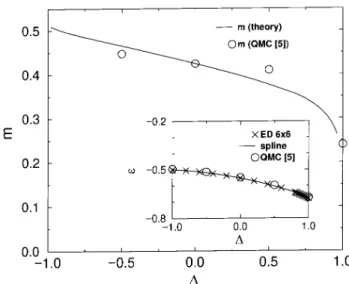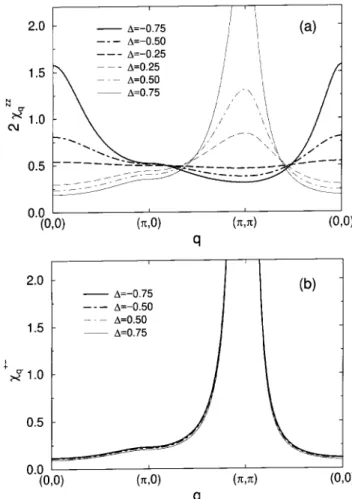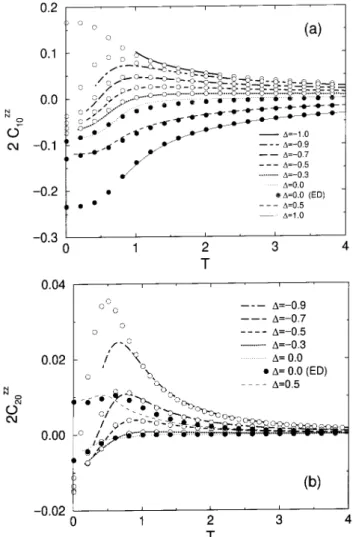Quantum to Classial Crossover in the
2D Easy-Plane XXZ Model
H. Fehske, C. Shindelin, A. Weie, H. Buttner,
PhysikalishesInstitut,UniversitatBayreuth,D-95440 Bayreuth,Germany
and D. Ihle
Institut f urTheoretishePhysik,UniversitatLeipzig,D-04109Leipzig,Germany
Reeivedon5August,2000
Ground-stateandthermodynamipropertiesofthespin-1/2two-dimensionaleasy-planeXXZmodel
are investigatedby both aGreen's-funtion approahand by Lanzos diagonalization onlatties
withupto 36sites. Wealulatethe spatialandtemperaturedependenesofvariousspin
orre-lationfuntions,aswellasthewave-vetordependeneofthespinsuseptibilityfor allanisotropy
parameters. Intheeasy{planeferromagnetiregion( 1<<0),thelongitudinalorrelators
ofspinsatdistanerhangesignatanitetemperatureT
0
(;r). Thistransition,observedinthe
2Daseforthersttime,anbeinterpretedasaquantumtolassialrossover.
I Introdution
The magneti properties of low-dimensional quantum
spin systems with spin anisotropy, suh as the
quasi-one-dimensional (1D) uprates [1℄ and the quasi-2D
high-T
parentompounds [2℄,areof growinginterest.
TheS=1=2XXZmodel
H= J
2 X
hi;ji (S
+
i S
j
+S
z
i S
z
j
) (1)
(hi;ji denote nearest-neighbor(NN) sites; throughout
we set J =1) usually servesas thegeneri model for
thosesystems.
Reently, in the ferromagneti(FM) region ( 1<
<0)of the1Dmodel aquantum-lassialrossover
inthelongitudinalspinorrelatorswasfoundbymeans
ofexatdiagonalization(ED)[3℄andaGreen's-funtion
theory [4℄. For the XXZ model on a square lattie,
an analytial approah to the spin suseptibility
tak-ing into aountmagneti short-rangeorder(SRO) at
arbitrarytemperaturesdoesnotyetexist.
Inthisontributionthespinorrelationsinthe
easy-plane region 1 < < 1 of the 2D XXZ model are
examined by both a Green's-funtion theory outlined
in the Appendix and by exat nite-luster
diagonal-izationsofthemodel(1)onlattieswithupto36spins
using periodi boundary onditions. Wemainly fous
on theharateristisof apossiblequantum to
lassi-alrossoverin theFM regime. Moreover,fortherst
time,theompletewave-vetor,temperatureand
de-suseptibilitiesarealulated.
II Ground-state properties
In Fig. 1 our resultsfor the magnetization m() are
omparedwithavailablequantumMonteCarlo(QMC)
data [5℄, where the ED/QMC data for the
ground-state energy per site "() (inset) is taken as input
for the Green's-funtion approah (C zz
10 =
1
2
"=,
C +
10
="=2 C zz
10 ).
Figure 1. Magnetization m and ground-state energy " of
tionsalulatedanalytiallyarein exellentagreement
withourEDdata. Letusstressthatthenite-size
de-pendene ofthe EDdata isalmost negligiblebygoing
from a32-toa36-sitelattie. At=1therotational
symmetry C +
r
= 2C zz
r
is visible. At the quantum
ritial point = 1 we have C +
r; ~
H = 2C
zz
r
= 1=6
(f. Eq. (14)). The non-analytial limiting behavior
lim
! 1
+C zz
r
=0resultsfromboththeQMC[5℄and
EDdata(obtainedinthesubspaewithtotalspin
pro-jetionS z
=0).
Thestati spinsuseptibilities
q
()are depited
in Fig.3. IntheFM region,forsuÆientlylow
val-ues, zz
q
showsamaximumatq=0beingapreursor
oftheFMinstability(inthezz-orrelators)at= 1.
Note that( +
Q )
1
=0,reetingthetransverse
long-rangeorder(LRO)atT =0,byEq.(13)orrespondsto
( +
0; ~
H )
1
=0. Inthe antiferromagneti(AFM) region
0<<1themaximumin zz
q
atq=Qis indiative
of thelongitudinalAFMLROat 1.
Finally,inFig.4weshowthelongitudinalspin-wave
spetrum ! zz
q
(f. Eq. (7)). Forq jqj 1wehave
! zz
q =
zz
s
q, where thespin-waveveloity zz
s
inreases
with over the whole easy-plane region. The
mini-mumin! zz
q
atq=Qin theAFMregion orresponds
to the maximum in zz
q
(f. Fig. 3a) and reets the
inreaseofthelongitudinalAFMSROwith(seealso
C zz
r
()in Fig.2).
Figure2. Transverseandlongitudinalspinorrelation
fun-tionsC
r
atT=0. SymbolsdenoteEDresultsobtainedfor
a66lattie.
Figure3. Wave-vetordependene ofthe longitudinal (a)
andtransverse(b)statisuseptibilities
q
atT =0.
III Finite-temperature results
Thetemperaturedependene of theshort-ranged
lon-gitudinalspinorrelationsisdisplayedinFig.5. Again
the analytial results agree remarkably well with the
EDdata. In the FM region, for the rst time in the
2Dmodel,weobservetheso-alled\sign-hanging"
ef-fetwhih wasfound numerially[3℄ in the 1Dmodel
and later on reprodued by our Green's-funtion
al-ulations [4℄. That is, at xed separationr and with
inreasing temperature or at xed temperature and
with inreasing r, C zz
r
hanges sign from negative
to positive values. The temperatures T
0
(;r) where
C zz
r (T
0
(;r);)=0aregiveninTableI.Asinthe1D
ase,T
0
atxed dereaseswith inreasing r.
How-ever,omparedtothe1Dase[4℄,ouranalytialresults
areinmuhbetteragreementwiththeEDdata.
The sign hange of C zz
r
may be interpreted as a
quantumtolassialrossover[3℄beausewith
inreas-ing temperature the system behaves more lassially,
i.e.,itbeomesdominatedbythepotentialenergy
(neg-ative term of the Hamiltonian favoring the parallel
alignmentoftwospins). IntheAFMregionweobtain
theexpetedalternatingsignsofC zz
thelongitudinalAFMSRO.
InFig.6varioussuseptibilities
q
atq=0;Qare
plottedasfuntionsofT andomparedwithnumerial
data. For =0:5thelongitudinalandtransverse
uni-form suseptibilities are in reasonableagreementwith
the QMC results [5℄ and our ED data (the up- and
downturn atlowertemperaturesis anite-sizeeet).
Theinreaseof
0
(T),themaximumneartheexhange
energy (J = 1), and the rossoverto the Curie-Weiss
lawareduetothedereaseofAFMSROwith
inreas-ing temperature. On the other hand, the staggered
suseptibility zz
Q
isenhanedasomparedwith zz
0 by
thelongitudinalAFMSRO.IntheFMregion(Fig.6b,
= 0:5) themaximumin zz
0
, wherethe analytial
and numerial results yield nearly the same position,
maybeexplainedasaombinedSROandsignhanging
eet as disussed forthe 1D model in Ref. [4℄.
Con-trarytotheAFMregion, zz
Q
issuppressedasompared
with zz
0
whihisausedbytheFMorrelationsabove
T
0 .
Figure4. TemperaturedependeneoftheNN(a)andnext
NN (b)longitudinal spinorrelation funtions C zz
r
.
Sym-bolsdenoteEDresultsobtainedfora44lattie.
Thetemperaturedependene of +
0 =
+
~ may
beexplainedagainasaSROeet.
Figure5. Longitudinalandtransversestatispin
susepti-bilities
q
as funtionsoftemperatureT forthe 2DAFM
(a)andFM(b)easy-planeXXZmodels.
Figure6. Longitudinalspin-wave dispersion! zz
q
alongthe
major symmetrydiretionsofthe2DBrillouinzone.
Here,thetransverseFMSROresultsinaspin
sti-nessagainsttheorientationofthetransversespin
om-ponents along a staggered eld perpendiular to the
z-diretion,sothat +
Q; ~
H
issuppressedatlow
Table1: TemperatureT
0
(;r)ofthesignhangeinthe
longitudinal orrelationfuntions C zz
r
(T;). The
or-responding resultsobtained from ED of a44 lattie
aregivenin parenthesis.
T
0 (;r)
r=(1;0) r=(1;1) r=(2;0)
-0.1 2.98[2.540℄ 1.76 1.76[1.520℄
-0.3 0.96[0.931℄ 0.74 0.72[0.713℄
-0.5 0.66[0.605℄ 0.52[0.527℄ 0.50[0.476℄
-0.7 0.46[0.391℄ 0.36[0.303℄ 0.34[0.301℄
-0.9 <0.2[0.125℄ <0.2[0.106℄ <0.2[0.106℄
IV Summary
To summarize, we presented a Green's-funtion
the-ory of magneti LRO and SRO in the 2D easy-plane
XXZ model whih allows the omplete alulation of
all stati magneti properties in exellent agreement
with numerial diagonalization data. In partiular,
in the FM region we found a quantum to lassial
rossoverinthelongitudinalspinorrelations. We
on-lude that our approah is promising for appliation
to otheranisotropispinmodels,suh asthequasi-2D
XXZmodelfortheparentompoundsofhigh-T
super-ondutors.
Appendix: Green's-funtion
the-ory
Thespinsuseptibilities +
q
(!)= hhS + q ;S q ii ! and zz q
(!) = hhS z q ;S z q ii !
, expressed in terms of
two-time retarded ommutator Green's funtions, are
de-termined bytheprojetionmethod,developed,forthe
XXZ hain, in Ref. [4℄. Taking thetwo-operator basis
(S + q ;i _ S + q ) T and(S z q ;i _ S z q ) T weobtain q (!)= M q ! 2 (! q ) 2
; =+ ;zz; (2)
with M + q = 4[C + 10 (1 q )+2C
zz 10 ( q )℄;(3) M zz q = 4C + 10 (1 q
); (4)
C nm C r , C + r = hS + 0 S r i, C zz r = hS z 0 S z r i, r =
ne x +me y , and q
= (osq
x
+osq
y
)=2. The spin
orrelatorsareobtainedfromEq.(2) as
C r = 1 N X q M q 2! q
[1+2p(! q )℄e iqr ; (5) where p(! q ) = (e
! q =T 1) 1
. The spetra !
q ,
al-ulated in the approximations S + =(! + ) 2 S + and S z q = (! zz q ) 2 S z q
introduing vertex parameters
i
(i=1;2),aregivenby
(! +
q )
2
= [(1+2 + 2 (C + 20 +2C + 11 )℄(1 q )
+(1+4 + 2 (C zz 20 +2C zz 11 )℄( q ) +2 + 1 [C + 10 (4 2 q 3 q ) +2C zz 10 (4 2 q 1 3 q
)℄; (6)
(! zz q ) 2 = 2(1 q
)[1+2 zz 2 (C + 20 +2C + 11 ) 2 zz 1 C + 10
(1+4
q
)℄: (7)
In the easy-plane region 1 < < 1, the
long-range order at T = 0 is reeted in our theory by
! +
Q
=0 [Q= (;)℄. Aordingly, the ondensation
partCe iQr
is separatedfrom C +
r
(f. Eq. (5)), and
themagnetization misalulatedas
m 2 = 1 N X r C + r e iQr
=C: (8)
The parameters
1
(T) are determined from the sum
rules C +
00
= 1=2 and C zz
00
= 1=4. To obtain
2 (T)
we adjust C
10
(T = 0) taken from our ED data and
assume,asadditionalonditions forthe alulationof
zz q (!)and + q
(!),temperatureindependentratios
R zz = zz 2 (T) 1 zz 1 (T) 1 (9) and R + > = + 2
(T) 1
+
1
(T) 1
for >0; (10)
R + < = + 2
(T) 1
zz
1
(T) 1
for <0; (11)
respetively. Forthedisussion itis usefulto perform
theunitary transformationwhih rotatesthe spinson
thesublattieBaroundthez-axisbytheangle, ~ S i = U + S i
U withU = Q
l2B 2S
z
l
. Weget ~ S x;y i =e iQri S x;y i , ~ S z i =S z i and ~ H= 1 2 X hi;ji ( S + i S j +S z i S z j
): (12)
DuetohAi
H =h ~ Ai ~ H
foranyoperatorA,weobtainthe
relations + q;H (!) = + k; ~ H
(!); k=q Q; (13)
C + r;H = e iQr C + r; ~ H ; (14) zz q;H (!) = zz q; ~ H
(!), and C zz r;H =C zz r; ~ H
. As shown in
Ref. [4℄, the rotational symmetry at = 1 is
Referenes
[1℄ D. C. Johnston, in K.H. J. Bushow, editor,
Hand-book of Magneti Materials, volume 10, Elsevier
Si-ene,(Amsterdam1997).
[2℄ M. Matsumura, F. Raa, and D. Brinkmann, Phys.
Rev.B60,6285(1999).
[3℄ K.FabriiusandB.M. MCoy,Phys.Rev.B59,381
(1999).
[4℄ C. Shindelin, H. Fehske, H. Buttner, and D. Ihle,
ond-mat/9911447.
[5℄ Y.OkabeandM.Kikuhi,J.Phys.So.Japan57,4351



